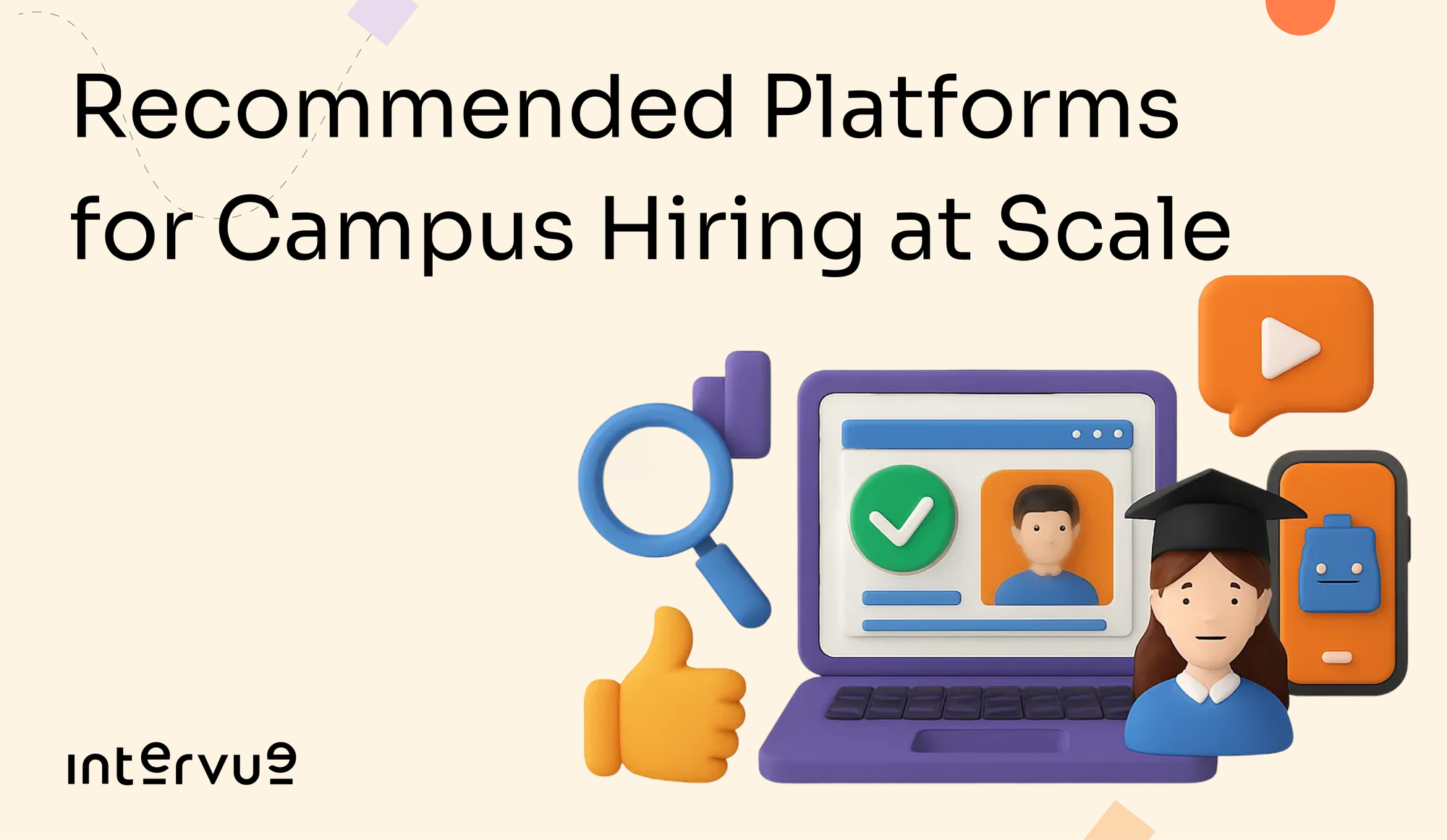Overview
Introduction
What are ATS-Integrated Scheduling Tools?
Why ATS Integration Really Matters (and What the Numbers Say)
The Benefits of ATS-Integrated Scheduling Tools
Top ATS-Integrated Scheduling / Interview Tools (and Their Tradeoffs)
How Intervue Can Be Your ATS-Integrated Scheduling Hero
Best Practices for Rolling Out a Scheduling-Enabled ATS Workflow
Summary & Call to Action
Your hiring needs to get stronger
Stay updated with our latest blog posts
In recruiting teams everywhere, scheduling interviews is often a hidden drain on time and energy. Between juggling calendars, chasing confirmations, handling time zones, and avoiding no-shows, even a “simple” interview can turn into a multi-hour headache.
What if your ATS and your scheduling tool were so tightly integrated that the system handles scheduling logistics automatically without you having to jump between platforms, export and import data, or dig into spreadsheets? That’s the sweet spot of ATS-integrated scheduling software.
Let’s dive in.
ATS-Integrated Scheduling Tools are recruiting software solutions that connect directly with an Applicant Tracking System (ATS) to automate interview coordination. Instead of switching between calendars, email, and spreadsheets, these tools let recruiters schedule interviews, sync availability, send reminders, and capture feedback all within the ATS. The result is faster hiring, fewer errors, and a smoother candidate experience.
Even in relatively mature recruiting teams, many workflows are fragmented:
- Recruiters manually export candidate data from ATS to scheduling tools
- Interview confirmations, feedback, and no-show data don’t always feed back into ATS
- Multiple tools mean context switching, duplication, and errors
According to ClearCompany, integrating ancillary tools into your ATS allows “automation of tedious work and making data accessible to everyone involved in the recruiting process”. Workable’s resources likewise emphasize that ATS integrations “expand the tools, features, and functionality that streamline the recruitment process.”
Perhaps more compelling: many teams report that poor integration causes manual data entry hell and fragmented candidate data. A recruiting director once quipped, “Our tools don’t talk to each other” as the top tech headache.
A study by Dell on HR transformation found that companies that automate 30 or more HR processes can boost productivity by up to 85%. While not limited to scheduling, it underscores how much uplift process automation can deliver
Faster Time-to-Hire
One of the clearest benefits of ATS-integrated scheduling is speed. Instead of endless email chains or manual back-and-forth, recruiters can lock in interview times with just a few clicks. According to industry research, the average time-to-hire hovers around 44 days in many sectors, far too long in competitive markets. Even shaving off a few days through automated scheduling can be the difference between securing a candidate and losing them to a competitor.
A Single Source of Truth
When scheduling happens outside the ATS, data quickly gets messy. Recruiters may log notes in one tool, interview confirmations in another, and feedback in yet another. Integration changes that. With all scheduling updates, reschedules, and confirmations automatically syncing back to the ATS, teams work from one central record. No more duplicate data entry or missed updates; everyone has the same view.
Better Candidate Experience
Candidates feel the impact too. Integrated scheduling tools often allow them to self-select from available slots, see everything in their own time zone, and receive automatic reminders. This reduces confusion, lowers no-show rates, and creates a more polished experience. A smoother scheduling process sends a clear signal: the company respects its time and values efficiency.
Operational Efficiency at Scale
Finally, integration reduces recruiter workload. Instead of juggling multiple logins and manually updating records, recruiters can focus on building relationships with candidates. Over time, that efficiency compounds. Fewer scheduling errors mean fewer reschedules, and fewer reschedules mean more time spent on meaningful conversations rather than admin tasks.
The ATS-integrated scheduling space is crowded, but a few platforms consistently make it into recruiter evaluations. Each takes a different approach: AI optimization, conversational bots, global coordination, or simplicity, and each has its limitations. Let’s walk through the landscape.
Intervue
Intervue approaches scheduling differently. Instead of being a standalone calendar tool, it treats scheduling as part of the interview journey itself. The moment a candidate is moved to the “Interview” stage in an ATS, Intervue handles everything: syncing calendars, coordinating panels, sending reminders, and capturing structured feedback in the same flow. Recruiters don’t have to bounce between tools or worry about whether data is syncing back.
Because it was designed for hiring from the ground up, Intervue doesn’t try to be all things to all people. It won’t replace your general meeting scheduler, and it isn’t meant to. Its strength lies in making interview scheduling seamless, candidate-friendly, and directly tied to your ATS. For teams that want fewer moving parts and a unified workflow, that focus is a meaningful advantage.
GoodTime
GoodTime has built its reputation on algorithmic scheduling. Its system automatically balances interviewer loads and recommends optimal slots, which can dramatically speed up high-volume hiring. Enterprises with complex calendars often benefit the most. At the same time, the sophistication comes at a price. Licensing can be expensive, and configuring the AI to match an organization’s specific processes isn’t always straightforward.
VidCruiter
VidCruiter offers one of the most comprehensive suites for interview management. Teams can set up live interviews, panel sessions, or even hybrid formats while relying on automated reminders and time zone adjustments. The breadth of functionality makes it attractive for large organizations. For leaner teams, however, the feature set can feel overwhelming, and adoption may require more training than expected.
Paradox
Paradox’s Olivia is a chatbot that handles scheduling through text, WhatsApp, or web chat. Candidates often find the experience intuitive because it mimics natural conversation. This modern approach works well for straightforward scheduling, but in edge cases like complex multi-round interviews or unusual rescheduling needs, the AI can struggle, requiring recruiters to step back in manually.
Calendly
Calendly remains one of the most recognizable names in scheduling. Its simplicity, ease of use, and embeddable links make it an appealing option, especially for companies that want quick wins. The trade-off is that Calendly was designed as a general meeting scheduler. It doesn’t natively handle multi-round interview loops, interviewer coordination, or structured ATS feedback, which means recruiting teams often need to supplement it with additional tools.
ModernLoop
ModernLoop focuses on making interview orchestration smoother in complex environments. It integrates directly with Slack, Zoom, and popular ATS platforms to help recruiters schedule entire loops in minutes. Larger teams running dozens of interviews daily often find value here. Smaller organizations, however, may struggle to realize the same ROI, as the platform’s capabilities sometimes exceed their needs.
Talview
Talview is particularly strong in global enterprises where candidates and interviewers are spread across time zones. Its intelligent rescheduling engine and real-time availability checks make it a reliable partner for distributed hiring. That said, Talview often feels like an enterprise-heavy solution. Leaner companies may find it more feature-dense than necessary, especially if their priority is simplicity over configurability.
Cronofy
Cronofy is not a full-fledged scheduling platform but rather a scheduling infrastructure provider. Its APIs handle complex availability logic for many ATS and HR tech vendors. For teams that want a building block to power custom workflows, Cronofy is unmatched. The limitation is obvious: it doesn’t provide the candidate- or recruiter-facing workflows by itself, so you need another tool layered on top.
As you know, Intervue.io is a platform designed for streamlined interview orchestration, candidate experience, and data-driven hiring. But what if it also owned the scheduling layer tightly and elegantly? Here’s how Intervue can flourish and win in this space, and in doing so, become the scheduling engine of choice for ATS-centric teams.
Intervue’s Unique Value Propositions (as a scheduling hero)
- Seamless ATS First Architecture: Intervue can be built so that scheduling is not “added on,” it is a native part of the candidate flow. When a recruiter moves a candidate to the “Interview” stage in the ATS, scheduling prompts in Intervue instantly. No manual export/import.
- End-to-End Sync (One Platform, One Throughline): Candidate status changes, reschedules, interview confirmations, cancellations, and outcomes all live in Intervue + feed back to ATS. No external silos or broken context.
- Conversational UI + Natural Language Rescheduling: A lightweight AI assistant (via chat or email) that helps candidates reschedule, propose alternate slots, or resolve conflicts. Paradox does this; Intervue can embed it more contextually.
- Panel / Round / Hybrid Scheduling: Intervue should natively support complex scheduling patterns: panels, sequential rounds, hybrid (e.g., video + in-person). It’s not just 1-on-1 slots.
- Adaptive to Scale: Whether you are a recruiting agency, a mid-size tech team, or an enterprise, Intervue should scale, multiple teams, hierarchical interviewer pools, global operations, many calendars, and thousands of interviews per month.
- Embedded Analytics & Insights: Because scheduling is part of Intervue’s core, you can deliver metrics like scheduling time, reschedule rates, no-show rates, and candidate drop-offs at the scheduling stage directly in your dashboards.
- Minimal Maintenance / Smart Failover: The integration layer should detect sync failures, auto-retry, surface errors intelligently, and fall back to safe defaults (e.g., notifying admins), reducing manual debugging.
- Security, Compliance & Governance Built-In: Given Intervue’s existing strengths, ensure scheduling inherits the same data security, role-based access, audit logs, and compliance protocols so scheduling data is never second-class.
Here are recommended steps (and pitfalls to avoid) for any team adopting Intervue (or any ATS-integrated scheduler).
1. Audit Your Existing Workflow & Data
- Map exactly how scheduling currently happens (tools, handoffs, pain points).
- List all fields, custom candidate metadata, and interviewer pools.
- Identify all calendar systems (Google, Outlook, etc.) in use and constraints (e.g. blocked times, private events).
2. Define Interview Templates & Workflows
- Instead of ad hoc scheduling, codify your interview flows (rounds, panels, buffer times). Use test runs to validate.
- Template-based scheduling reduces error and configurability.
3. Pilot with a Subgroup
- Start small: pick one department or team (e.g., engineering interviews) to pilot the integrated scheduling.
- Track the time before vs. after, errors, support tickets,and candidate feedback.
4. Monitor Key Metrics
Track:
- Scheduling time per candidate
- Number of reschedules / conflicts
- No-show rate
- Candidate drop-off rate during scheduling
- Support tickets linked to scheduling errors
- Let data drive iterative improvements.
5. Train Your Users & Document Edge Cases
- Users (recruiters, interviewers) must understand how the system handles conflicts, overrides, etc. Document fallback flows (if someone declines or the interviewer gets blocked last minute).
- Ensure you define escalation paths (e.g., notification to admin if scheduling fails).
6. Build Fallback & Error Handling Logic
No system is perfect. Your scheduler should detect sync failures, overlapping events, DST shifts, etc., and surface them so admins can intervene gracefully (not letting candidates slip through gaps).
7. Iterate & Learn
Collect feedback from recruiters, interviewers, and candidates. Improve heuristics over time (e.g., better rescheduling logic, smarter buffer zones, alternative slot suggestions).
In modern talent acquisition, the scheduling stage often becomes the friction bottleneck. Tools may promise to automate, but unless your scheduling layer is truly integrated with your ATS, you still end up with context switches, errors, and manual work.
Teams that adopt scheduling tools with deep ATS integration gain speed, consistency, better data visibility, and improved candidate experience. We saw several strong contenders above, from GoodTime to VidCruiter to Paradox, each with its strengths and tradeoffs.
But the real hero in this space can be Intervue, if built with scheduling as a first-class citizen. With seamless sync, smart scheduling logic, embedded analytics, and an interface that treats scheduling as part of the interview journey (not an add-on), Intervue can deliver a better, smoother experience than the patchwork alternatives.
Your hiring needs to get stronger
Stay updated with our latest blog posts






